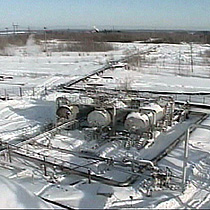
The Russo-Chinese Energy Follies
Publication: China Brief Volume: 8 Issue: 23
By:

Chinese and Russian officials habitually proclaim that their bilateral relations have never been better and thereby invoke a great congruence in their agenda for the international regime. Thus Viktor Kremenyuk, deputy director of the U.S. and Canada Institute in the Russian Academy of Sciences, writes that Russia, “Is successfully crowding out the United States from its position as China’s No. 1 partner, and over time could become that country’s quasi-ally” [1]. Yet the fact of the matter is discernibly different. The recent fiasco surrounding Russian energy firms’ endeavors to obtain a loan from China’s National Petroleum Corporation (CNPC) for their operations reveals the numerous strains on the Russo-Chinese relationship.
In October both sides announced a new deal to ensure the supply of Russian oil to China through the East Siberian Pacific Ocean Pipeline (ESPO) that would branch off to China at Skovorodino to China’s largest terminal in Daqing, a city in the northeast province of Heilongjiang (New York Times, October 29; Agence France Presse, October 28). As that agreement was being signed, Rosneft and Russian energy firms were appealing to China for loans to bail them out (New York Times, October 29; Agence France Presse, October 28). China agreed to lend Rosneft $15 Billion and Transfect $10 billion on the condition that Moscow guarantees completion of the pipeline and a shipment of 15 million tons of oil (300,000 barrels/day) to China through ESPO to Skovorodino and Daqing by 2011. These conditions reflect China’s earlier irritation at Russia’s stalling and failure to deliver on energy projects, but also represent that China is no longer averse to using its economic leverage to compel other states to conclude deals that are to China’s advantage.
Russian Prime Minister Vladimir Putin even had to say that Russia now welcomed Chinese investments. This is directly contradictory to his past actions such as the case in 2002 when the Russian government rejected Chinese investment in Slavneft (The Associated Press, October 28). In a similar vein, Deputy Prime Minister Aleksandr’ Zhukov told the Russo-Chinese bilateral commission that Russia favored both countries making mutual investments in each other’s economies. Oleg Safonov, the presidential plenipotentiary in the Russian Far East (RFE), also promoted the idea of mutual reciprocal investments, specifying Chinese investment in not only basic product as timber processing, but also in the high-tech sectors of aircraft construction, nanotechnology and energy (Vladivostok Times, November 9; Northeast Asian Peace and Security Network, NAPSNET, November 10).
Yet such rosy scenarios are unlikely to materialize. As of January 2008, direct Russian investments in China totaled $14.2 million and direct Chinese investments in Russia stood at $415 Million (Interfax, October 27). This disparity is only likely to grow as the global economic crisis and falling energy prices force Russia to retract its economic ambitions. Meanwhile, Chinese investment in Russia is likely to increase because Russia cannot sustain its position in the Far East without large-scale foreign investment. Thus, a consortium of Chinese engineering firms led by Harbin Turbine will be building coal-fired turbines in the RFE to generate 41,000 megawatts of new generating capacity by 2011. Stanislav Nevynitsyn, executive director of the Russian power producer OGK, admitted that, “It is simply a necessity for us to work with the Chinese—we will not have the capacity to build otherwise” (International Herald Tribune, May 5). Therefore Russia is becoming increasingly dependent upon Chinese capital investments in developing its regional infrastructure.
Even so, the scheme for Chinese loans failed almost at once. China apparently had first agreed on 7 percent interest and then changed its mind to request that the interest be pegged to the higher Libor rate (London International Bank for Settlements). Russian sources denounced China’s demands as imposing “absurd lending conditions” and the talks collapsed on November 12. The talks, however, resumed six days later; but optimism that the loan and other accompanying issues would be satisfactorily and quickly resolved may both be premature (Reuters, November 12; The Associated Press, November 18).
What was signed is not a conclusive deal to build the ESPO link from Skovorodino or a bailout of Russian firms (Agence France Presse, October 28). Much hard bargaining lies ahead and, based on the previous experience, there lies a lengthy shadow between the agreement and the execution of the deal (Agence France Presse, October 28). Even if talks over the loan are resumed, there is still no agreement on the price of the energy shipments involved or certainty as to when the pipeline will be finished. For example, Russian officialdom remains divided over ESPO’s prospects. Transneft’s vice-president, Mikhail Barkov, said it would be commissioned at the end of 2009 and reach full capacity in 2011 (Interfax, April 3). Yet Energy Minister Sergei Shmatko recently told the sub-commission on energy cooperation of the Russo-Chinese commission that there is no way that ESPO could be launched in 2009 (Interfax, April 3). The current economic crisis makes it much harder for Russia to raise the capital it desperately needs to develop its Siberian energy sites and invest in infrastructure to hold up its end of the ESPO bargain [2]. Given the inveterate rent-seeking, graft, and suboptimal economics of Russia’s energy sector, cautions about projecting a completion date for ESPO, especially in the absence of an agreement on energy prices, is amply warranted.
This flop typifies Russo-Chinese bilateral energy relations. Russian oil deliveries to China, which now go by rail, evidently failed to meet their targets in 2007 and in fact fell ten percent from January-November 2007 (Interfax, December 25, 2007). Revelations of delays in ESPO and of further declines in Russian oil shipments to China in January 2008 have further compounded these problems [3]. For the first 8 months of 2008, Gazprom could not provide CNPC with any oil due to a dispute with Kazakhstan. By September, when Moscow was finally prepared to resume shipments, China had already begun looking into alternative arrangements with other suppliers to buy oil fields elsewhere (Zhongguo Jingying Bao Online, October 8).
Similarly, Gazprom is now trying to get out of its plans to sell gas to China (BBC News, June 19). Russia has deleted costs associated with designing a gas pipeline from the Sakhalin-1’s project 2008 gas budget because Russia cannot produce enough gas to satisfy its Asian, domestic and European markets. Under a downward pressure on its net supply, Gazprom sacrificed the Chinese market for its domestic needs, confirming rising suspicions that Russia, under its current and foreseeable production levels, cannot satisfy the rising demand of its Asian, European and domestic customers for energy (Interfax, December 21; Far Eastern Economic Review, January-February 2008). As a result, China must try to induce Gazprom to supply it with gas even though it previously sought to avoid dealing with Gazprom at Sakhalin-1 in 2006 by signing a Memorandum of Understanding (MoU) with Exxon-Mobil. Furthermore, it is unlikely that Gazprom will refrain from driving Exxon-Mobil into a minority status as it has done on Sakhalin-2 with Mitsubishi, Mitsui and Shell. Thus China, if it wants gas from Sakhalin, will have no choice but to deal with Gazprom, which is trying to prevent it from getting gas so that it can give priority to the Russian domestic market (Interfax, December 21, 2007; Far Eastern Economic Review, January-February 2008). Moreover, China is insulted by the fact that Sakhalin-2 will start selling gas to Japan in 2009 and plans to build a pipeline to the Sea of Japan, thereby bypassing China and rewarding Japan (Nikkei Telecom21 Internet Version, December 22, 2007). Perhaps this is one of the factors driving Beijing to demand more Russian supply of nuclear energy through participation in tenders for reactors to be built in China (Nezavisimaya Gazeta, December 21, 2007).
Similarly, Russia now must delay construction of its projected gas pipeline to China due to competition for other gas sources in China. These competitors arose mainly due to Russia’s own dilatoriness in negotiating and then building this pipeline (Forbes, October 8). The Altai pipeline, designed to ship 30 billion cubic meters (BCM) of natural gas to China annually from Western Siberia, was excluded from Russia’s new blueprint for the gas industry because of a variety of issues, including the price that China would pay for the gas. The Altai pipeline proposal was hamstrung by the fact that it would be less competitive than gas coming to China from Turkmenistan (Forbes, October 8; RIA Novosti, October 6).
This brief list hardly exhausts the entirety of Russia’s failed promises that have led to China upgrading its energy quest in Central Asia and becoming a direct competitor of Russia. Despite an undoubted congruence on certain key political issues between them, a genuine alliance is still premature. Meanwhile, China has used the global economic crisis as an opportunity to launch a massive domestic investment program whereas the Russian government has been busy bailing out inefficient state-run firms and companies belonging to favored oligarchs. Furthermore, Russia’s actions have not been intended to improve the competitiveness of these enterprises, but to keep them from falling into the hand of foreign investors. Moreover, Russia, as the foregoing narrative suggests, still has no viable program for developing its Far East which is already coming under pressure to integrate with China. Therefore, against the backdrop of the current global economic crisis, a widening gap between the “strategic partners,” rather than greater congruence, is likely to develop in the near future.
Notes
1. V. Kremenyuk, “U.S. Foreign Policy In a Presidential Election Year,” International Affairs (Moscow), No. 5, 2008, p. 47
2. “Russia, China: Extending ESPO, www.stratfor.com Analysis, October 27, 2008, www.stratfor.com/analysis/20081027_russia_china_extending_espo
3. Stephen Blank, “Asia and Russian Energy Under Dmitri Medvedev: What Can Be Expected,?” Northeast Asia Energy Forum, Summer, 2008, V, NO. 2, pp. 31-41





